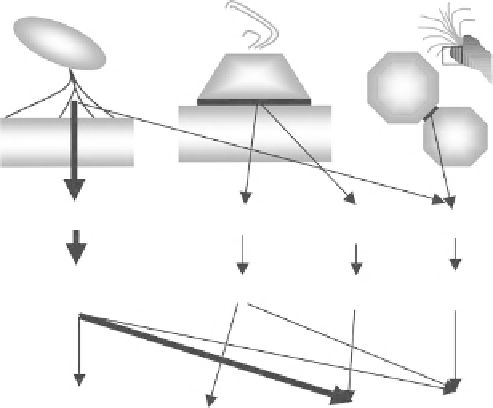Biomedical Engineering Reference
In-Depth Information
What learned
from nature
Functional group
Sequence
Specific
conformation
Processing
DOPA in polymer,
recombinant, peptide,
extracts from animal
Type of
material
Peptide
Recombinant Polymer,
recombinant
Form of
product
Adhesive
in humid
environments
Gel-like material
Self-assembly
Functional coating
Fig. 9.7
Impacts to artificial material designs
troublesome reaction [
73
,
74
]. Recently, metal-coordination bonding via DOPA is a
further trend to form intermolecular cross-linking [
75
,
76
]. The bonding is possibly
reversible, thus self-healing and tough mechanical properties are expected. In the
case of metal-coordination bonding, the free catechol group instead of the quinone is
essential. The chemical incorporation of DOPA seems to have priority in those cases
of metal-coordination bonding due to easy control of the chemistry. The gel-like
materials formed by DOPA cross-linkage may be available for tissue sealants and
drug delivery systems inmedical applications, although it is not known how good the
properties of the materials will be. Moreover, the addition of tyrosinase or harmful
oxidants and metals to form the gel may be unwelcome for medical applications. The
current process for using the material is also not yet practical.
Great impacts of DOPA/catechol have been found in the area of coating/surface
functionalization of materials. Incorporation of DOPA into a polyethylene glycol
(PEG) backbone was the first applicable case of a coating material [
77
]. The
material, adsorbed onto titanium, prevented the fouling of the surface by mammalian
cells for 6 months. DOPA-structure in the material was employed as the anchor and
the anti-fouling property was given by the PEG-structure. After the initial report,
adaptation of DOPA/catechol as a surface anchoring structure was investigated
extensively and is now a platform for materials design. Materials with DOPA/
catechol-anchor structure include anti-fouling coatings against proteins [
78
],
cells [
79
], and animals [
80
], functionalizing surfaces [
81
,
82
], and gels [
83
].
Apart from DOPA, protein-based materials are another choice to anchor foreign
functional proteins to material surfaces. Two barnacle proteins with surface

Search WWH ::

Custom Search